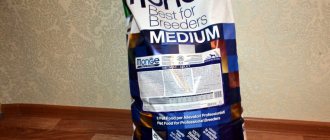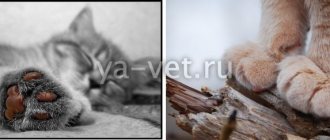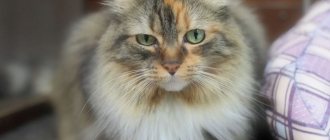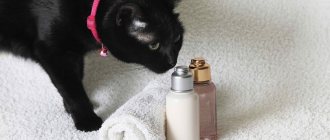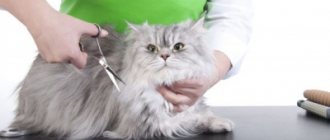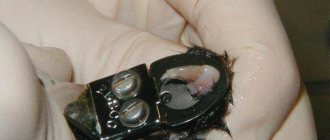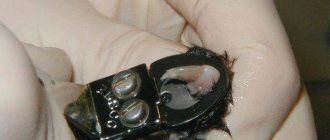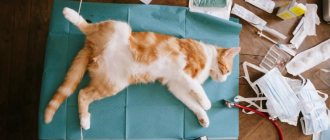- Cats
Some owners of cats and cats, in order to keep the interior of their home safe and sound, to protect family members, especially children, from the threat of being scratched, decide on a rather complex operation - declawing cats, which is called onychectomy.
Features of the operation
During this surgical operation, the claws are removed along with the entire terminal phalanx of the fingers. Veterinarians are mostly opposed to onychectomy. Considering the medical aspect, it should be noted that the removal of the phalanges of the fingers in cats is a very risky procedure: harm from general anesthesia, the risk of infection, and the risk of severe bleeding. If claws are removed incorrectly, the regeneration process may begin over time - the claws grow back, but very often they grow inside the foot, causing pain and suffering in the animal. There is a need for repeated declawing surgery to avoid extensive inflammation of the limbs.
Postoperative care
After surgery, the animal will require special care and attention. To alleviate the animal's suffering, repeated administration of painkillers will be required. To avoid infection of the wound, the sutures must be regularly treated with antiseptic agents. In addition, to prevent the cat from licking its wounds, it should wear a medical collar for two weeks. Three days after the operation, the doctor will examine the patient and give an opinion on the progress of the healing process.
How is the operation soft paws for cats performed?
If you have made a conscious decision to have a soft paw surgical procedure, it is important to find a good veterinarian who will competently and skillfully perform this operation. It is usually performed under general anesthesia. No one “rips out” the claws, the doctor carefully removes them using special tools, the pillows are not injured, sutures are placed on the incisions, it is better if they are absorbable. The paws are bandaged to protect them from bleeding. Additional medications may be prescribed to help the cat recover better from anesthesia.
Post-operative cat care
Usually after 6-10 hours
The cat can already move independently.
It is recommended to keep an eye
on her for at least
a day or two until she completely recovers from anesthesia; this time is individual for each animal.
Veterinarians recommend providing the animal with a comfortable bed on the floor, limiting walking and jumping in the first hours after surgery, and not allowing jumping from a height. Day or two after surgery
The paws may bleed and the cat will feel uncomfortable stepping on them, but within 10-12 days everything should return to normal and the cat will continue to run, play and jump on cabinets.
Consequences of the operation
The consequences of the operation may include the following conditions:
- Severe blood loss with serious complications including death
- Loss of coordination due to the need to rely on the pads of the paws rather than on the toes
- Deterioration of gait and subsequent atrophy of the muscles of the limbs and back
- Regeneration of the claw and its ingrowth into the soft tissues of the foot, which leads to repeated surgery
- Long and painful healing process
Given the many risks and unintended consequences, Operation Soft Paws, as onychectomy is commonly called, is drawing protest from animal lovers. The European Convention protecting animal rights has banned onychectomy in many European countries. And even in those countries where this operation is permitted, such as in Russia, veterinarians are opposed to onychectomy.
After declawing, cats may develop arthritis due to the emphasis placed on the pads of their feet when walking. The muscles of the paws and back atrophy, coordination of movements is impaired. A cat that has experienced stress due to this inhumane operation feels completely defenseless, its character deteriorates, and it increasingly uses its last weapon of defense - its teeth.
Is it worth declawing?
Claws are an integral part of cats, so removing them also removes a fairly large area of the finger adjacent to the claw, as can be seen in the photo. This leads to the fact that after the operation the cat cannot move in the usual way.
In fact, she has to learn to walk again, because the foot becomes shorter, and the overall balance will also be disrupted due to the redistribution of the load between the muscles. There is no guarantee that the cat will be able to continue to move with the same grace as before. A photo of a cat with its claws removed is a very sad and unusual sight.
If the operation is incorrect, an infection may occur, and in addition, there is a possibility that the removed part of the finger will begin to regenerate after some time and the claw will grow again, only inside the foot, which will cause not only severe pain, but also infection.
Changes in the cat’s psychological health are also inevitable, because it will be deprived of its main weapon. Reviews from cat owners who have had their pet declawed also include comments that previously cheerful and friendly animals become nervous and unsociable.
They may also begin to frequently use their last weapon - their teeth. Some even stop using their toilet tray, as they are associated with discomfort when they are unable to “bury” the litter, as reviews indicate.
There is an opinion that declawing kittens is less painful than adult cats, but this is wrong. Yes, kittens may outwardly endure surgery more easily, but in any case they experience severe pain as their damaged paws heal. Don't forget that declawing a cat is equivalent to cutting off the last phalanx of a person's fingers.
Arguments of supporters of onychectomy
Despite protests from animal rights activists, declawing cats has become fashionable in many countries around the world at some point. Proponents of this operation believe that it is completely safe for the health of the animal. Because declawing occurs under general anesthesia, they say, the cat experiences no pain. Cats begin to walk normally after 5-7 days.
Private veterinary clinics advertise onychectomy, and it becomes one of their areas of activity. Often the operation is performed at home if the cat owner arranges a call to a veterinary surgeon, not wanting to take the animal to the clinic. In this case, the cost of declawing is slightly increased compared to the cost of surgery in a hospital.
Private veterinary services usually warn that declawing can only be performed on cats that are constantly kept at home. If the owners plan to take their pets to the dacha in the summer, where they can come into contact with other animals, then this operation cannot be carried out so that your cat does not remain defenseless against aggression from its own kind. For the same reason, onychectomy is not possible if your cat is outdoors.
Of course, after declawing, the cat will never again sharpen its claws on your furniture, sofas and armchairs will remain intact, and no one will scratch your hands. Therefore, declawing cats is the price for your peace of mind. If you decide to have this operation, then you need to take into account that it is best to carry it out at an early age, then the cat will quickly get used to walking without claws. You can remove claws either on the front paws only, or on all four. After the operation, it is necessary to put a special collar on the cat for two weeks so that it does not remove the bandages from its paws and does not lick the wounds.
And these days, such questions as pros and cons, opinions of specialists and owners and many others related to the onychectomy operation cause fierce debate between its supporters and opponents. Remember, this little creature that you brought into the house is completely in your power, and you simply must create all the conditions for its normal development and good health. After all, you are responsible for him.
Possible complications after surgery soft paws for cats
On the Internet you can find a lot of “horror stories” about onchyectomy. The opinion is expressed that the animal becomes disabled with a broken psyche, its character changes for the worse. Cats move worse, the harmony of the musculoskeletal system is disrupted. But a cat's claws are not used when walking and supporting themselves.
, since it rests on the first and second phalanges of the fingers, and the last claw phalanx remains retracted.
Claws are needed only for hunting and protection from enemies .
Complications after this operation , a description of which can be found on the Internet, occur as a result of poor quality performance: a fragment of the distal phalanx is left, non-absorbable threads are used for sutures, and aseptic conditions are violated.
Myths and truth about the consequences after surgery: soft paws for cats
There are also cases described when a cat becomes cowardly, aggressive, and unkind due to the “soft paws” procedure. Most people who agree to this operation for their pets do not notice such negative changes in the cat’s character; its gait, coordination and behavior do not change.
Where can they remove claws and how much does it cost?
Not all clinics provide onychectomy, and prices for declawing are quite high. However, everywhere they offer a less radical alternative - nail trimming, which costs from 200 to 500 rubles , depending on the clinic, the cost may vary. In addition, another alternative has recently become widespread - silicone pads. As you can see in the photo, they are put on the claws and last from 3 to 5 weeks.
You need to know that declawing surgery is carried out strictly only for domestic animals, because while walking on the street, the cat will not be able to protect itself in case of danger, or simply climb a tree if attacked by a dog. If you
- Chinchilla
- Dog breeds
- Urban dog breeds
- Origin of the cat
- Hypoallergenic dogs
- Fighting dog breeds
After all, we definitely decided that the cost of declawing cats ranges from 1,500 to 4,000 rubles. But currently, many animal protection organizations are fighting to ban declawing in Russia, and many veterinary clinics refuse to do it. In any case, before deciding on such an intervention in the life of an animal, you should think carefully.
Photo of the process of declawing cats
How to train a kitten to use a litter box - correctly, quickly and easily train a cat to use a litter box (125 photos)- How to raise a kitten - tips and recommendations on how to properly raise an affectionate and tame kitten (135 photos)
How to get rid of the smell of cat urine - 125 photos of ways to remove the unpleasant smell of a cat
Read here Flea collar: effectiveness, reviews and review of the best models of 2021 (115 photos)
Help the site, share with friends 
2
Alternative
In order for everything in the house to remain in its original form, you should simply wean the cat from sharpening its claws on household objects. To do this, you can purchase a scratching post or make one yourself, building a whole play complex for your beloved pet. The main thing is not to put it off for a long time - it is very difficult to retrain an animal that is already accustomed to sharpening its claws on a soft sofa or a wooden chair leg. In addition, there are special silicone claw covers for animals that refuse to be trained.
The only thing to remember in this situation is that the pads need to be changed monthly.
The best way is to trim the tips of your nails. A more gentle method than surgery is to trim the tips of the claws with special tweezers. Pet owners who are inexperienced in this procedure should be extremely careful. It is preferable to contact a veterinarian so that he can show you how far the claws can be cut. After all, they contain blood vessels, which during the process of circumcision can be damaged and cause in the poor animal not only fear of such a procedure, but bleeding and inflammatory processes.
Should you trim your cat's claws?
Many owners are of the opinion that they should control the growth and sharpness of their cat’s claws on their own. The difficulty is that the animal's claw is riddled with nerve endings that can be easily damaged during trimming. In addition, forced pedicure has other side effects:
- Trimming the nail plate often ends in splitting it. If the crack reaches the blood vessels, the cat can easily get an infection when it tries to sharpen its claws on its own;
- It is difficult to determine “by eye” where the animal’s nerve fibers end in the claw without experience;
- Constant trimming leads to accelerated nail growth, which adds trouble to the owner.
On average, a cat's nails need to be trimmed once a week. It is not always convenient to constantly take the animal to the veterinarian for this, and performing the procedure on your own is risky.
Feedback from pet owners
Vita Trushechkina
But I no longer doubt it. I already decided, today, after the cats went crazy, ran around like crazy and scratched our 9 month old daughter who was sitting playing on the floor. I'm not even talking about how scared she was. And yesterday I saw how one of the cats wanted to hit my daughter, but saw me and ran away. So I won't wait for them to claw her eyes out. I love our cats, but the child and his safety are more important.
Svetlana Skibenko
I'm sorry, but why are we talking only about sofas? Let's talk about the hostess's health! My cat is very affectionate and peaceful, he has been in our family since two months and has seen only tenderness - he is our favorite. But sometimes he has attacks of aggression or fear (for example, he was afraid of a working food processor) - he attacks me, his mistress. He has already repeatedly torn my legs to pieces, a couple of times even the ambulance took me away. The doctors advised me to get rid of the cat, but, again, I love him very much and don’t want to part with him. But I am still constantly afraid of his attacks. My legs are covered in terrible scars and in the summer I can’t even go to the beach! Moreover, this threatens blood poisoning. So what should I do - sacrifice the cat or is it better to use his claws?!
Jennifer
We declawed our cat. And it was a damn good decision. While all the wallpaper in our house was torn, shreds of carpets flew in all directions, etc. I endured it, trimmed the cat’s claws, ran after him with a scratching post, and so on. He sneezed on me and all my efforts. But when he with his claws jumped onto the hanger where my expensive leather jacket from Italy and my husband’s equally expensive sheepskin coat were hanging…. and, clinging to the jacket with one paw and the sheepskin coat with the other, he slid down, tearing shreds out of our clothes - this was the last straw. He was given general anesthesia and only the claws on his front paws were carefully removed. A week later he was jumping around like a saiga.
